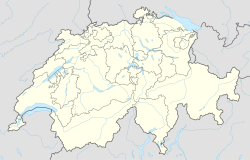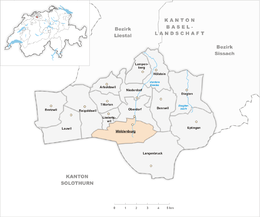Waldenburg BL
| Waldenburg | ||
|---|---|---|
 |
||
|
||
| Coordinates: 47°23′N 7°45′E / 47.383°N 7.750°ECoordinates: 47°23′N 7°45′E / 47.383°N 7.750°E | ||
| Country | Switzerland | |
| Canton | Basel-Landschaft | |
| District | Waldenburg | |
| Government | ||
| • Mayor | Kurt Grieder | |
| Area | ||
| • Total | 8.3 km2 (3.2 sq mi) | |
| Elevation | 532 m (1,745 ft) | |
| Population (Mar 2017) | ||
| • Total | 1,184 | |
| • Density | 140/km2 (370/sq mi) | |
| Postal code | 4437 | |
| SFOS number | 2895 | |
| Surrounded by | Langenbruck, Liedertswil, Mümliswil-Ramiswil (SO), Oberdorf, Reigoldswil | |
| Website |
www SFSO statistics |
|
Waldenburg is a municipality in the canton of Basel-Country in Switzerland, and the capital of the district of the same name.
Waldenburg has an area, as of 2009[update], of 8.3 square kilometers (3.2 sq mi). Of this area, 2.61 km2 (1.01 sq mi) or 31.4% is used for agricultural purposes, while 5.18 km2 (2.00 sq mi) or 62.4% is forested. Of the rest of the land, 0.48 km2 (0.19 sq mi) or 5.8% is settled (buildings or roads) and 0.01 km2 (2.5 acres) or 0.1% is unproductive land.
Of the built up area, housing and buildings made up 3.9% and transportation infrastructure made up 1.6%. Out of the forested land, 60.0% of the total land area is heavily forested and 2.4% is covered with orchards or small clusters of trees. Of the agricultural land, 0.1% is used for growing crops and 16.4% is pastures, while 1.3% is used for orchards or vine crops and 13.6% is used for alpine pastures.
The municipal coat of arms was introduced in 1926; it is that of the counts of Frohburg, who owned the village at the time of its first mention (1244); its blazon is Or, an Eagle displayed Vair, langued, beaked and membered Gules.
Waldenburg has a population (as of March 2017[update]) of 1,184. As of 2008[update], 27.2% of the population are resident foreign nationals. Over the last 10 years (1997–2007) the population has changed at a rate of -9.8%.
Most of the population (as of 2000[update]) speaks German (1,067 or 80.3%), with Albanian being second most common (104 or 7.8%) and Italian being third (56 or 4.2%). There are 5 people who speak French and 1 person who speaks Romansh.
...
Wikipedia




